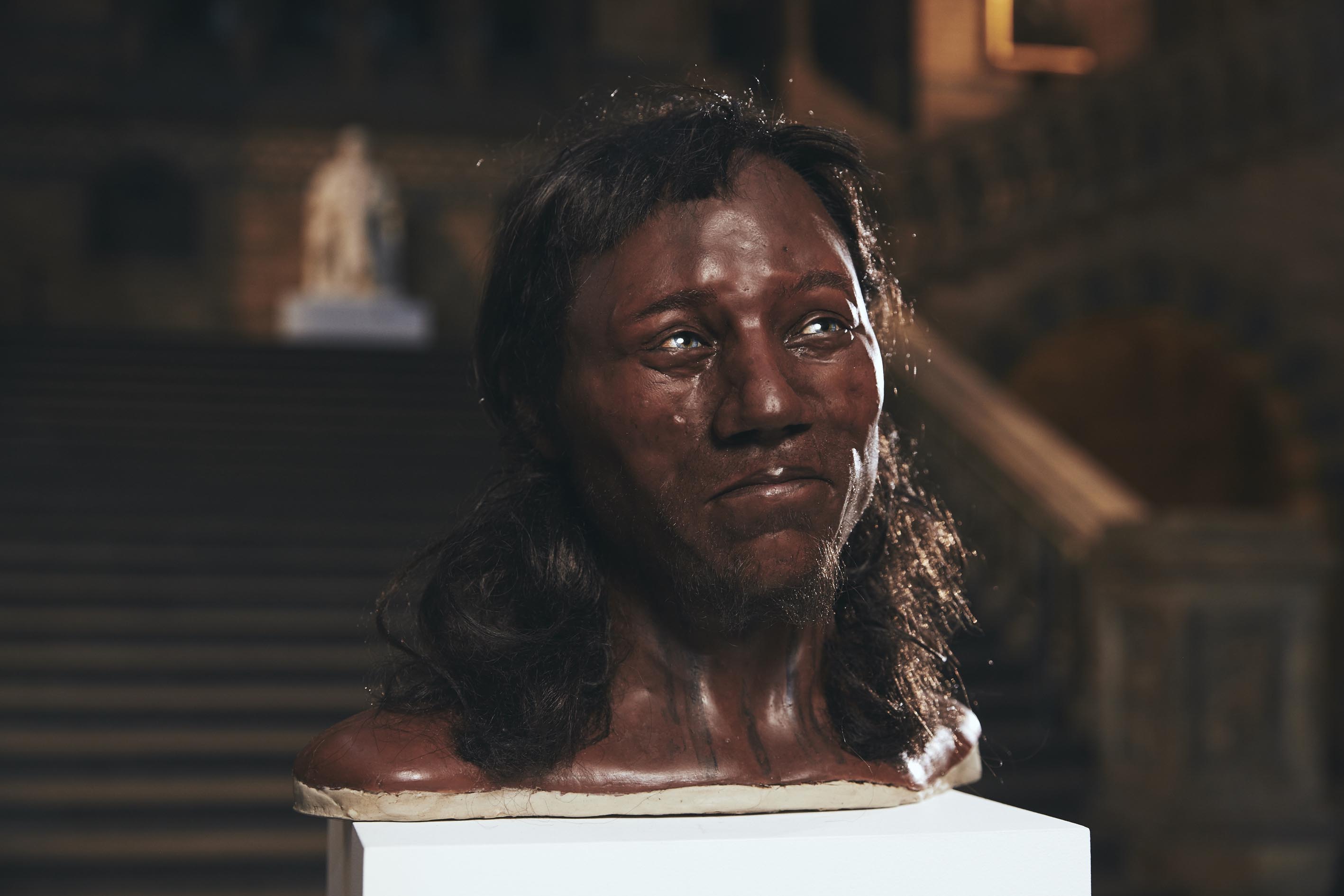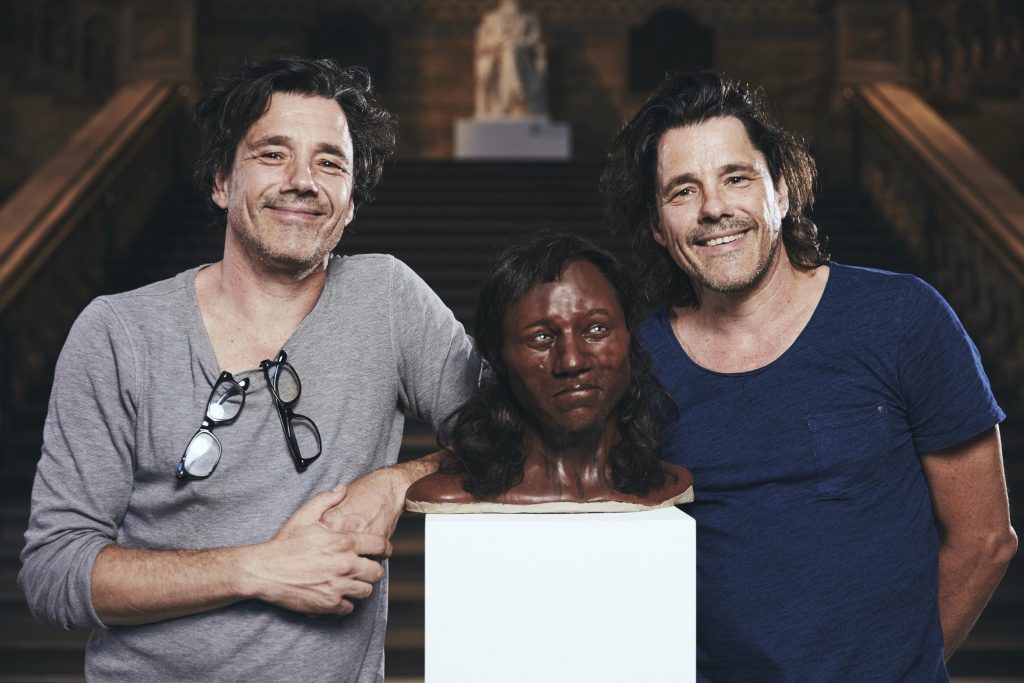
DNA work carried out by researchers from the Natural History Museum (NHM) and University College London (UCL) has shed new light on Cheddar Man, a skeleton discovered 103 years ago in Gough’s Cave, Somerset.
Specialists from the NHM have succeeded in extracting viable DNA from the 10,000 year-old-skeleton, a first for a British individual of that age. Professor Ian Barnes, Research Leader in Ancient DNA, and his colleague Dr Selina Brace, carried out the first ever full DNA analysis of Cheddar Man, made possible by spectacular breakthroughs in DNA sequencing. Working in the NHM’s ancient DNA lab, Professor Barnes and Dr Brace drilled a hole, 2mm in diameter, into the skull, allowing them to obtain a few milligrams of his bone powder for analysis. As the DNA was unusually well-preserved, possibly due to the cool, stable conditions in the cave, they were able to extract sufficient genetic information to inform the facial reconstruction.
Ian Barnes, says: “Cheddar Man is one of the oldest human specimens that we’ve worked with, and yet the preservation of DNA has been good enough to recover huge amounts of information about his appearance and ancestry. It’s been fantastic working with this excellent team, and getting to sample one of the most important human skeletons in the museum collection.”
Professor Mark Thomas and Dr Yoan Diekmann at University College, London, analysed the sequences generated at the NHM to establish what Cheddar Man looked like. The results indicate that he had dark to black skin pigmentation, along with dark curly hair and blue eyes. This means that the lighter pigmentation, now considered to be a defining feature of northern Europe, is a far more recent phenomenon than had previously been thought.
Cheddar Man’s genetic profile places him with several other Mesolithic-era Europeans whose DNA has already been analysed – individuals from Spain, Hungary and Luxembourg. These Western Hunter-Gatherers, as they are known, a group that includes Cheddar Man’s ancestors, migrated into Europe at the end of the last ice age. Today, around 10% of White British ancestry can be linked to that population.

Building on the advanced genetic testing of Cheddar Man’s 10,000-year-old bones, two of the world’s foremost palaeontological model makers, Dutch identical twins Adrie and Alfons Kennis, have recreated his entire head with more accuracy than any previous attempts. The Kennis brothers are experts in recreating scientifically accurate animals and humans, with a focus on human evolution. To allow the model makers to reconstruct Cheddar Man’s face using 3D printing, the NHM team employed the use of a hi-tech scanner, originally designed for use on the International Space Station, to render his skull in full detail.
A Channel 4 documentary, to be shown on 18th February 2018 at 8pm, entitled The First Brit: Secrets of the 10,000 Year Old Man, follows the researchers as they help to put the flesh back on Cheddar Man’s bones. The hour-long film is part of Channel 4’s Secret History series. Steven Clarke, who directed the film made by Plimsoll Productions, says: “This is one of the most exciting programmes I have ever worked on. To see the face of the first Brit, someone we could all be related to, is absolutely fascinating. Especially today, when questions of personal and national identity are being debated.”
Leon Troake, operations manager at Cheddar Gorge & Caves, says: “We now know so much more about this very special individual who lived in Cheddar Gorge 10,000 years ago. To be able to completely reconstruct what Cheddar man looked like in so much detail from such a small amount of DNA is incredible. We now know about his skin colour, hair, facial features and eye colour, which has not been possible until now. Visitors to Gough’s Cave will now not only be able to see where Cheddar man was discovered but also have a good idea of what he looked like and imagine what life would have been like so long ago. Hopefully this is just the start for the team involved in this research, and will allow them to expand their knowledge.” He adds: “We’re delighted to be playing a part in these historic findings.”
Cheddar Man’s skeletal remains, on loan from Longleat Enterprises Ltd, can be seen in the NHM’s Human Evolution Gallery in London and a replica of the skeleton is exhibited in Gough’s Cave close to where it was discovered in 1903.

Cheddar Man does not share any direct ancestry with the people who inhabited Gough’s Cave nearly 5,000 years earlier. Dr Sylvia Bello and Professor Chris Stringer of the NHM, who first excavated at Gough’s Cave 30 years ago, have spent the last ten years analysing the bones of the earlier inhabitants of the cave. These temporary visitors came during an ice–age thaw, but were driven out – like all previous humans in Britain – when temperatures dropped again. They have identified the remains of six individuals: three adults, two adolescents and a young child, aged approximately 3 years old, all of whom all sustained human butchery or chewing damage. The study of cups made from human skulls suggests cannibalistic behaviour was driven by a type of ritual rather than starvation.
Chris Stringer says: “This latest work shows that even a British cave discovery from over a 100 years ago can be completely re-evaluated using new study techniques. As these continue to develop, we will be able to learn even more.”
